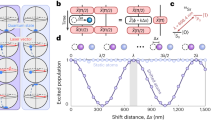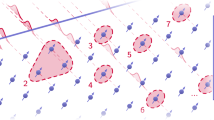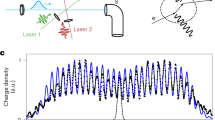Abstract
In recent years, substantial progress has been made in exploringand exploiting the analogy between classical light and matter waves for fundamental investigations and applications1. Extending this analogy to quantum matter-wave optics is promoted by the nonlinearities intrinsic to interacting particles and is a stepping stone towards non-classical states2,3. In light optics, twin-photon beams4 are a key element for generating the non-local correlations and entanglement required for applications such as precision metrology and quantum communication5. Similar sources for massive particles have so far been limited by the multi-mode character of the processes involved or a predominant background signal6,7,8,9,10,11,12,13. Here we present highly efficient emission of twin-atom beams into a single transversal mode of a waveguide potential. The source is a one-dimensional degenerate Bose gas14 in the first radially excited state. We directly measure a suppression of fluctuations in the atom number difference between the beams to 0.37(3) with respect to the classical expectation, equivalent to 0.11(2) after correcting for detection noise. Our results underline the potential of ultracold atomic gases as sources for quantum matter-wave optics and should enable the implementation of schemes previously unattainable with massive particles5,15,16,17,18,19.
This is a preview of subscription content, access via your institution
Access options
Subscribe to this journal
Receive 12 print issues and online access
$259.00 per year
only $21.58 per issue
Buy this article
- Purchase on SpringerLink
- Instant access to full article PDF
Prices may be subject to local taxes which are calculated during checkout




Similar content being viewed by others
References
Cronin, A., Schmiedmayer, J. & Pritchard, D. Optics and interferometry with atoms and molecules. Rev. Mod. Phys. 81, 1051–1129 (2009).
Deng, L. et al. Four wave mixing with matter waves. Nature 398, 218–220 (1999).
Orzel, C., Tuchman, A. K., Fenselau, M. L., Yasuda, M. & Kasevich, M. A. Squeezed states in a Bose–Einstein condensate. Science 291, 2386–2389 (2001).
Heidmann, A. et al. Observation of quantum noise reduction on twin laser beams. Phys. Rev. Lett. 59, 2555–2557 (1987).
Reid, M. D. et al. Colloquium: The Einstein–Podolsky–Rosen paradox: From concepts to applications. Rev. Mod. Phys. 81, 1727–1751 (2009).
Vogels, J., Xu, K. & Ketterle, W. Generation of macroscopic pair-correlated atomic beams by four-wave mixing in Bose–Einstein condensates. Phys. Rev. Lett. 89, 020401 (2002).
Gemelke, N., Sarajlic, E., Bidel, Y., Hong, S. & Chu, S. Parametric amplification of matter waves in periodically translated optical lattices. Phys. Rev. Lett. 95, 170404 (2005).
Campbell, G. K. et al. Parametric amplification of scattered atom pairs. Phys. Rev. Lett. 96, 020406 (2006).
Spielman, I. B. et al. Collisional deexcitation in a quasi-two-dimensional degenerate bosonic gas. Phys. Rev. A 73, 020702 (2006).
Perrin, A. et al. Observation of atom pairs in spontaneous four-wave mixing of two colliding Bose–Einstein condensates. Phys. Rev. Lett. 99, 150405 (2007).
Dall, R. G. et al. Paired-atom laser beams created via four-wave mixing. Phys. Rev. A 79, 011601 (2009).
Jaskula, J-C. et al. Sub-Poissonian number differences in four-wave mixing of matter waves. Phys. Rev. Lett. 105, 190402 (2010).
Klempt, C. et al. Parametric amplification of vacuum fluctuations in a spinor condensate. Phys. Rev. Lett. 104, 195303 (2010).
Petrov, D. S., Shlyapnikov, G. V. & Walraven, J. T. M. Regimes of quantum degeneracy in trapped 1d gases. Phys. Rev. Lett. 85, 3745–3749 (2000).
Dunningham, J., Burnett, K. & Barnett, S. Interferometry below the standard quantum limit with Bose–Einstein condensates. Phys. Rev. Lett. 89, 150401 (2002).
Horne, M. A., Shimony, A. & Zeilinger, A. Two-particle interferometry. Phys. Rev. Lett. 62, 2209–2212 (1989).
Hong, C. K., Ou, Z. Y. & Mandel, L. Measurement of subpicosecond time intervals between two photons by interference. Phys. Rev. Lett. 59, 2044–2046 (1987).
Rarity, J. & Tapster, P. Experimental violation of Bell’s inequality based on phase and momentum. Phys. Rev. Lett. 64, 2495–2498 (1990).
Gneiting, C. & Hornberger, K. Bell test for the free motion of material particles. Phys. Rev. Lett. 101, 260503 (2008).
Estève, J., Gross, C., Weller, A., Giovanazzi, S. & Oberthaler, M. K. Squeezing and entanglement in a Bose–Einstein condensate. Nature 455, 1216–1219 (2008).
Maussang, K. et al. Enhanced and reduced atom number fluctuations in a BEC splitter. Phys. Rev. Lett. 105, 080403 (2010).
Folman, R., Krüger, P., Schmiedmayer, J., Denschlag, J. & Henkel, C. Microscopic atom optics: From wires to an atom chip. Adv. At. Mol. Opt. Phys. 48, 263–356 (2002).
Schumm, T. et al. Matter wave interferometry in a double well on an atom chip. Nature Phys. 1, 57–62 (2005).
Stimming, H-P., Mauser, N., Schmiedmayer, J. & Mazets, I. Fluctuations and stochastic processes in one-dimensional many-body quantum systems. Phys. Rev. Lett. 105, 015301 (2010).
Perrin, A. et al. Hanbury Brown and Twiss correlations across the Bose–Einstein condensation threshold. Preprint at http://arXiv.org/1012.5260 (2010).
Hofferberth, S., Lesanovsky, I., Fischer, B., Schumm, T. & Schmiedmayer, J. Non-equilibrium coherence dynamics in one-dimensional Bose gases. Nature 449, 324–327 (2007).
Bücker, R. et al. Single-particle-sensitive imaging of freely propagating ultracold atoms. New J. Phys. 11, 103039 (2009).
Pu, H. & Meystre, P. Creating macroscopic atomic Einstein–Podolsky–Rosen states from Bose–Einstein condensates. Phys. Rev. Lett. 85, 3987–3990 (2000).
Duan, L-M., Sørensen, A., Cirac, J. I. & Zoller, P. Squeezing and entanglement of atomic beams. Phys. Rev. Lett. 85, 3991–3994 (2000).
Hohenester, U., Rekdal, P. K., Borzì, A. & Schmiedmayer, J. Optimal quantum control of Bose–Einstein condensates in magnetic microtraps. Phys. Rev. A 75, 023602 (2007).
Acknowledgements
We acknowledge support from the FWF projects P21080-N16 and I607, the EU projects AQUTE, QuDeGPM and Marie Curie (FP7 GA no. 236702), the FWF doctoral programme CoQuS (W 1210), the FunMat and NAWI GASS research alliances, the City of Vienna and Siemens Austria. We wish to thank E. Altman, A. Gottlieb, B. Hessmo, K. Kheruntsyan, I. Mazets, M. Oberthaler, H. Ritsch and G. von Winckel for stimulating discussions.
Author information
Authors and Affiliations
Contributions
R.B., S.M. and T. Berrada collected the data presented in this letter. J.G. and U.H. provided the OCT calculations for the excitation sequence. All authors contributed to analysis and interpretation of the data and helped in editing the manuscript.
Corresponding author
Ethics declarations
Competing interests
The authors declare no competing financial interests.
Supplementary information
Supplementary Information
Supplementary Information (PDF 241 kb)
Rights and permissions
About this article
Cite this article
Bücker, R., Grond, J., Manz, S. et al. Twin-atom beams. Nature Phys 7, 608–611 (2011). https://doi.org/10.1038/nphys1992
Received:
Accepted:
Published:
Issue date:
DOI: https://doi.org/10.1038/nphys1992
This article is cited by
-
Time-of-flight quantum tomography of an atom in an optical tweezer
Nature Physics (2023)
-
Entanglement-enhanced matter-wave interferometry in a high-finesse cavity
Nature (2022)
-
Observation of pairs of atoms at opposite momenta in an equilibrium interacting Bose gas
Nature Physics (2021)
-
Spin Squeezing for Two Atoms in an Optical Coherent-State Cavity
International Journal of Theoretical Physics (2020)
-
Nonlinear dynamics of the cold atom analog false vacuum
Journal of High Energy Physics (2019)



